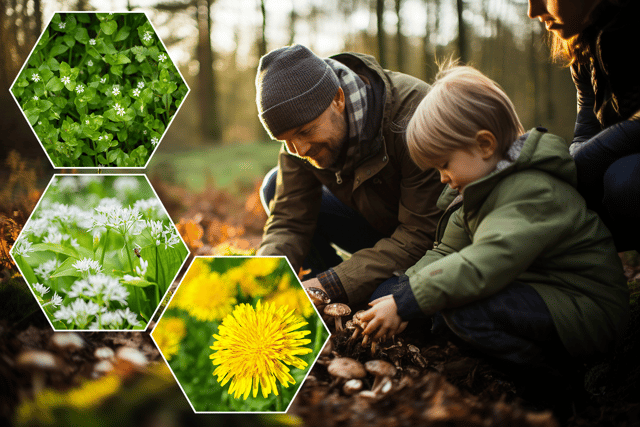Spring foraging in the UK: Easy wild foods to find out walking - and how to harvest safely and sustainably
This article contains affiliate links. We may earn a small commission on items purchased through this article, but that does not affect our editorial judgement.
It might still formally be winter, but in southern parts of the UK trees have already started to erupt with pink and white blossoms, while streets echo with the springtime songs of garden birds.
Foraging for wild foods has recently grown in popularity as a way to enjoy the outdoors and connect with nature, as the weather warms. But if you're keen to incorporate the hobby into your own spring routine, you need to learn how to do it right. Experts at outdoors-wear company Blacks and renowned chef Paul Robinson - known as 'The Yorkshire Gourmet' - have teamed up to offer advice on the best way Britons can safely and sustainably enjoy foraging on their springtime walks this year.
Advertisement
Hide AdAdvertisement
Hide Ad“Foraging for wild foods is a great way to add some flavour to your outdoor adventures," author Adam Warrington, one of Blacks' resident adventurers, says. "Nature has an array of ingredients that are free for UK walkers. As long as you are in a public space or have the landowner's permission, foraging in the UK is a great way to explore all the tastes and flavours that Mother Nature has to offer.”
It was important to start simple when foraging, he continued. "Choosing to forage recognisable fruits such as brambles is a great way to start. It is also a good idea to cross-reference multiple foraging books if you are unsure of what you are picking.”
However, the food available to foragers changes drastically throughout the year, from fruits and berries one season to mushrooms the next. With this in mind, here are some of the best things to pick in the coming months:


The best things to forage in Spring
While spring might seem like the season of flower power, to foragers, it's an ideal time to get more greens in. One of the most popular wild greens this time of year is wild garlic - which is easy for beginners to both spot, and smell.
Advertisement
Hide AdAdvertisement
Hide AdThe vibrant green plant can be identified by its long, oval-shaped leaves with pointed tips and smooth edges. It will pop up in low-growing clusters in dark and shaded areas, and will have bright white flowers in spring, and an unmistakeable raw garlic smell. While it typically blooms between April and June, the very first leaves will begin to appear in March - and the young leaves taste the best. Wild garlic is a versatile allrounder in the kitchen, and also works incredibly as a base for pesto.
Cheery yellow dandelions will soon be popping up almost everywhere. As well as signalling the coming spring, these flowers - commonly maligned as weeds - and their leaves are a tasty and potassium-rich treat. The Yorkshire Gourmet advises that the green leaves are a great addition to salads, pastas, or risottos. However, one of their most popular uses in the North is in dandelion and burdock cordial (here's a recipe) - which makes for a sweet and refreshing drink as the weather warms.
Another wildflower which is most prominent in the spring is chickweed, so-named because it used to be fed to chickens. But its spicy, potent herbal flavour lends itself to many uses in the kitchen too. It makes the perfect accompaniment to meat, and adds a real kick to roasted potatoes or cauliflower - and whole stalks can also work great in stir fries.
Chickweed can be identified by its star-shaped clusters of leaves growing on upright stalks, usually in dense patches. At this time of year it is usually topped with dainty, white flowers, and can be found most anywhere, from coastal paths and cliffs to fields, farmyards and gardens.
Advertisement
Hide AdAdvertisement
Hide AdHow to forage safely and sustainably
Harvesting sustainably is vital when it comes to foraging, with some parks even banning the practice due to people taking too much. It's important to remember - especially with greens - that they are also important food for wildlife, like bees and deer.
You should always collect food from abundant sources only (meaning you can see plenty of it around), and only take what you need for your own, personal use. You shouldn't dig up entire plants either, as this usually kills them. Instead, just carefully pick leaves or stalks.
Other important things to remember for your own safety are to make sure you know what you're picking, as plants and particularly mushrooms may have lookalikes which can be poisonous. If you're new to foraging, you should invest in a good foraging guide - or perhaps even two, so you can cross-reference what you find.
You should also avoid picking plants growing besides busy roads, carparks, or high-traffic areas, which may be contaminated with heavy metals and exhaust fumes. The same goes for low-growing or ground plants in popular dog-walking spots, which may have been exposed to faeces or urine.
Finally, if you're on or crossing private property at all, please ask permission from the landowner before you pick anything. It's only polite, after all.
Comment Guidelines
National World encourages reader discussion on our stories. User feedback, insights and back-and-forth exchanges add a rich layer of context to reporting. Please review our Community Guidelines before commenting.
